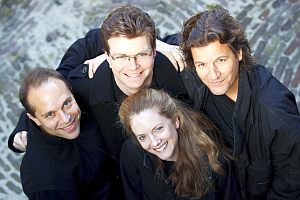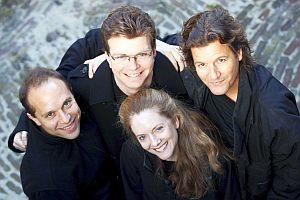Featuring the inimitable St. Lawrence String Quartet, Stanford Lively Arts’ “Sundays With the St. Lawrence” series has become one of the more consistently rewarding events on the Bay Area music calendar. Sunday in Dinkelspiel Auditorium, the foursome, Stanford’s ensemble in residence since 1998, returned with a special guest to continue its ongoing exploration of the chamber repertoire.

The guest was violist Hsin-Yun Huang, and the repertoire was a tempting mix of music from the 18th, 19th, and 20th centuries. Huang was a particular asset in the afternoon’s featured work, Brahms String Quartet in G Major, Op. 111. Yet the St. Lawrence’s musical interests don’t end with the tried and true. Instead of “the Three Bs,” as violinist Geoff Nuttall explained, the program was built along the lines of “two Ps and a B.” Thus, before the Brahms, the audience heard Prokofiev’s String Quartet No. 2 in F Major, Op. 92, “Kabardinian,” and the Quintet No. 1 in D Major by John Frederick Peter.
From the refined charms of the Peter quintet to the symphonic scope of the Brahms, the St. Lawrence delivered it all with brilliant focus, vibrant energy, and tonal allure. Now in their 22nd season, the quartet’s members — Nuttall, violinist Scott St. John, violist Lesley Robertson, and cellist Christopher Costanza — are master interpreters, possessed of a distinctive, authoritative sound.
With the addition of Huang, the Brahms Quintet simply sang. The Taiwan-born artist, a member of the Borromeo String Quartet from 1994 to 2000, employs a lithe, vivacious technique, and she and Robertson imbued the quintet’s zesty first movement with admirable weight and warmth. Still, it’s the cello that anchors the movement, and Costanza’s playing was an ideal blend of poise and eloquence.
The players eased into the Adagio, emphasizing fluidity and letting Brahms’ beguiling series of variations unfold organically; here again, the cultivated teamwork of Huang and Robertson spoke volumes. St. John’s playing in the Allegretto’s main theme registered with uncommon potency.
The gypsy music of the whirling finale is among Brahms’ finest — the composer intended this quintet as his final work, but, not surprisingly, it inspired a flurry of output thereafter — and the St. Lawrence gave it an incisive edge that was thrilling.
Bold Music Composed in the Caucasus
Nor was there anything recessive in the first half’s extroverted performance of Prokofiev’s “Kabardinian” Quartet. Composed in 1941 — when, as the German front advanced toward Moscow, the Soviet regime sent many of its artists to outlying republics — the score is named for the Kabardian folk tunes Prokofiev heard for the first time during a four-month stay in Nalchik.
The then-50-year-old composer, who was working on his opera War and Peace during the same period, was clearly inspired by what he heard in this region beyond Georgia and near the Turkish border. The first movement’s grim, ominous opening theme yields to a more relaxed, characterful march; the slow movement’s cello melody, which Costanza voiced assertively, effectively fuses form and feeling. The composer incorporates various plucked, strummed, and percussive string techniques in the go-for-broke finale, which seems to traverse a vast terrain. The St. Lawrence players made it a memorable trek.
The String Quintet of John Frederick Peter, which opened the program, was doubtless new to many in the audience; as Nuttall observed, that 18th-century composer may be best-known for having three first names. He’s also generally considered America’s first composer of chamber music. If this work, dated 1789, was the program’s novelty, it came across exuding considerable charm. The St. Lawrence, adopting a spry tone, danced through the outer movements with humor and high spirits; the slow movement was notable for its sense of refinement. Here again, Huang proved an essential element in the proceedings.
The St. Lawrence String Quartet will play twice more this spring at Stanford Lively Arts: On April 22, the group plays a Good Friday Concert featuring Haydn’s Seven Last Words of Christ on the Cross. On May 1, the “Sundays with the St. Lawrence” series concludes with the West Coast premiere of a new work by Argentine composer Osvaldo Golijov.

